Nigeria has varieties of breeds of goats that are special and peculiar in their diverse ways. I will explain their features, classification, uses and habitat below.
Sahelian Goats
Sahelian goats originated from West Africa.
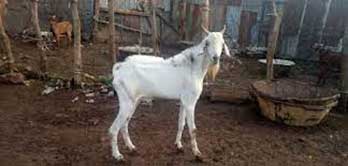
They thrive more in the desert and semi-desert environment. They give birth mainly at the age of 18 months and can give birth to one or two kids at a time. Their average lactation period is between five and six months. They are mostly affected by high humidity and are distributed mainly in the northern part of Nigeria. It has other names like Cheèvre bariolée, Gorane, Nioro, Niafounké, Sahélienne.
Classification
Sahelian goats fall under the Savanna group of goats.
Features/Characteristics of Sahelian Goats
- Thin appearance
- Narrow-body
- Shallow chest
- Sloping short croup
- Long spindly legs
- Udder, as well as scrotum in males, split into two halves
- Both sexes have horns
Uses of Sahelian Goats
They are used mainly for meat and skin production.
Habitat
The most comfortable environment for Sahelian goats is a desert or semi-desert environment.
2. Saanen Goat
Saanen goat originated from the western side of Switzerland. It is also called Saanenziege. It is highly productive.
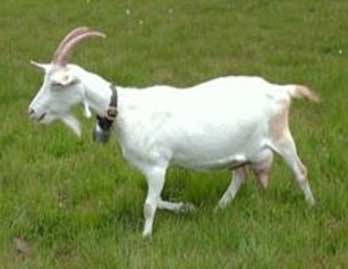
Classification
Saanen goat is classified as a dairy breed because of its high milk production. It can produce three gallons of milk in a day.
Features/Characteristics
- Pure white, smooth, silky fur
- A slender build
- A dainty manner of walking.
- Ears and nose often appear pink.
- Elegant carriage
- Amber eyes
Uses
It is used mainly for milk production. The milk it produces is highly nutritious.
Habitat
It is a domestic animal and is reared at home. It is intolerable to intense sun.
3. Maradi Goat
Maradi goats are commonly red, and they originated from southwest Asia. It is mainly found in Sokoto and is called Sokoto goat.
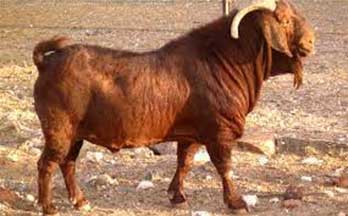
Classification
They are classified under dairy breeds.
Features/Characteristics
- Relatively small size 60 cm
- Mucous membranes black
- Horns in both sexes
- Short ears
- Males carry a light mane extending to the shoulders
- Short neck
- Rounded Chest
Uses
It is used for meat, milk production, and skin for water carriers.
Habitat
It thrives more in semi-arid areas.
4. African Dwarf Goats
This small and stunted goat originated from central Africa. They have high resistance to diseases and breeds in multiples. It has other names like Fouta Jallon, Grassland Dwarf or Chèvre Naine des Savanes, etc.
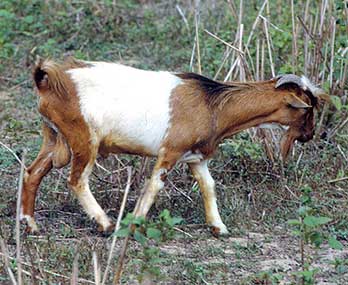
Classification
It is classified under dairy breeds.
Features/Characteristics
- Both sexes have horns, which curve outward and backwards in males
- Males also have beards and sometimes manes.
- Long neck
- Broad chest
- Straight back
- Shot legs
- Short, stiff hair
Uses
It is kept as livestock for meat and milk.
Habitat
Humid and subhumid zones are the major habitat of African Dwarf goats.
5. Pygmy Goats
Pygmy goats originated through African Dwarf goats. The British took it to their country during the colonization of West Africa, and from there, pygmy breeds were obtained.
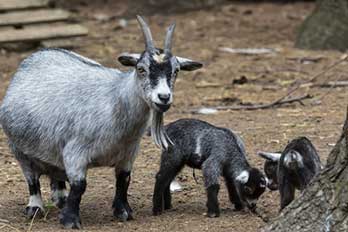
Classification
They are classified as dairy breeds
Features/Characteristics
- Short legs and head
- Well-muscled, stocky body
- Broad and deep barrel
- Short limbs and head.
- Broad forehead
- Erect ears, goat wattles, and horns.
- Short, wide, and flat nose with a rounded muzzle.
Uses
Its uses are for meat and milk production.
Its skin is also for skin production. Some people use it as a pet too.
Habitat
Their habitat is mainly farmland.
6. Anglo-Nubian Goats
Anglo-Nubian goat is a domestic goat that originated from cross-breeding between native British goat and lop-eared goat, which came from India.
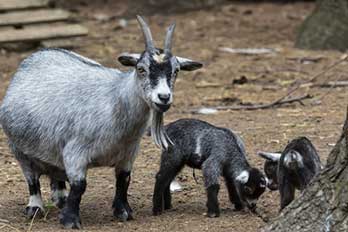
Classification
It falls under the dairy breed.
Features/Characteristics
- Long legs
- Long pendulous lop ears.
- The head is carried high
- The females have a short and smooth coat
- The males have rough and longer coat
Uses
It is reared for both goat meat and milk.
Habitat
They can live in hot climates but mainly prefer to graze under temperate climates. If the place is well ventilated, with grass around, they can thrive in such an environment.
